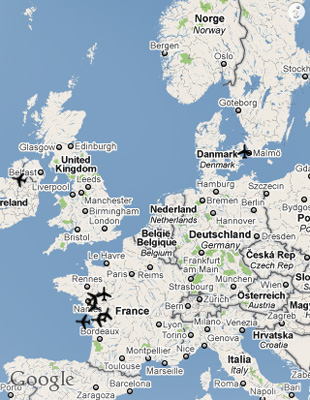Today’s EU Forecast : Much Of The Same Volcanic Ash
Following yesterday’s massive and unprecedented airspace closure over Europe yesterday due to volcanic ash cloud caused by the eruption of Iceland’s Eyjafjallajokull volcano much of Europe’s airspace remains closed today.
As of yesterday an estimated 6,000 flights were canceled due to the volcanic ash cloud moving over Europe. The last estimates were that a total of more than 12,000 flights could be impacted before the airspace of impacted areas are opened again … if not higher.
Yesterday many airports expected to return to by this afternoon, while most airports expect their airspace to be closed until early Saturday Morning. London’s Heathrow Airport expects to reopen at 01:00 on Saturday, however weather conditions are being monitored by Eurocontrol, the international agency responsible for air traffic control in Europe. Airspace closures may be extended or reduced based up the movement of the volcanic ash cloud.
Yesterday more than 300 trans-Atlantic flights were scheduled fly to Europe, however less than 120 were able to arrive at their destinations. Today air travel in unaffected areas has reduced the scheduled 28,000 flights to 11,000 flights in the European airspace according to Eurocontrol.
Presently the nations impacted by the airspace closures in Europe are : United Kingdom, Ireland, Norway, Netherlands, Belgium, Switzerland, France, Denmark, Southern Sweden, Germany, Finland, Latvia, Estonia, Lithuania, Czech Republic, Austria, Poland.
Much like yesterday, the airspace over Iceland is not closed and ReykjavÃk-KeflavÃk Airport remains open.
Below is a graphic of Europe’s nearly completely empty airspace, except for a very few aircraft appearing on the radar from 1:30pm GMT. Most days this graphic of live air traffic would be full of aircraft. Below this graphic is a from the UK’s Met Office showing the scope of the volcanic ash cloud over Europe as of 6:00pm GMT this morning.
Happy Flying!




One Comment